Bredbury
| Bredbury | |
| Cheshire | |
|---|---|
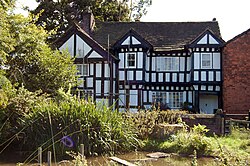 Goyt Hall | |
| Location | |
| Grid reference: | SJ925915 |
| Location: | 53°25’14"N, 2°6’49"W |
| Data | |
| Population: | 13,593 (2011) |
| Post town: | Stockport |
| Postcode: | SK6 |
| Dialling code: | 0161 |
| Local Government | |
| Council: | Stockport |
| Parliamentary constituency: |
Hazel Grove |
Bredbury is a suburban town in Cheshire, found 2 miles east of Stockport and 4 miles southwest of Hyde. It is 8 miles southeast of Manchester. At the 2001 census it had a population of 15,126.
The village reaches to the lower southern slopes of Werneth Low, an outlier of the Peak District between the valleys of the River Tame and River Goyt, headwaters of the River Mersey.
History
Iron Age
The area must have been unattractive to the Brigantes settlers in pre-Roman Britain, with its bleak hilltop, the heavy clay soil of the intermediate land probably covered by trees and becoming marshy where the slopes flattened out, and the swampy valley floors. The rivers flowed more fully before their waters were dammed in the 19th century to supply Manchester, Stockport and other towns. However, where the valley of the River Goyt narrows at New Bridge, passage was possible, and here an ancient highway entered the village to proceed along the higher land to the north east.
Roman occupation
The Romans surveyed and constructed a road between the forts of Mamucium (Manchester) and Ardotalia (Melandra Castle at Gamesley) over this ancient track and this in turn became an 18th-century turnpike road and the Liverpool to Skegness trunk road, the A560.
Some years ago a Roman coin was dug up on the edge of the road between Bredbury railway station and St Mark's Church. The coin long antedates any Roman occupation of this part of the country, and may either have been lost when held as a souvenir or have been brought over from the continent in the course of trade.
As with the majority of hills, rivers and other natural features in this area, the names of the River Tame and Werneth Low are of Celtic origin. The name Bredbury is Anglo-Saxon and probably dates from the first permanent settlement. Names found in nearby villages suggest that Norse invaders found their way into the district, probably during the 10th century.
Middle Ages
Bredbury comprised farm land bought by Lord Danton in 1014. There is no mention of Lord Danton's manor, but the 'lord' of Bredbury was the pre-conquest Anglo-Saxon thegn, Wulfric. It is likely that William the Conqueror's army, on its march from Yorkshire to subdue the rebellion at Chester, followed the main highway. Virtually all the townships on the way were systematically looted, part of the Harrying of the North. Bredbury seems to have been an exception, for reasons which are not clear, but the army apparently crossed the hill into Romiley, which although not on the direct route, is duly described as 'waste' in the Domesday Book of 1086. Bredbury itself was mentioned briefly in the Domesday Book as being several hundred acres of land. The only occupants listed were a duck and a sheep. Its value was placed at three pounds.
Bredbury passed from the hands of Sir Richard de Vernon to the Mascis of Dunham, under whom it was held by the Fitz-Waltheofs of Stockport. A charter granted by the third Hamon de Masci, lord of Dunham, who died about the end of the reign of King John, confirms the ownership of lands in Bredbury to the Fitz-Waltheofs, and is of special interest because it affords an insight into the working of the feudal system of the period. A translation of the charter runs as follows:
And I, Hamo, regrant to Robert, the son of Waltheof, Bredbury and Brinnington, with their appurtenances, as his inheritance, to him and his heirs, to hold of me and my heirs, by the service of carrying my bed, my arms or my clothing, whenever the Earl of Chester in his own proper person shall go to Wales. And I, Hamo, will fully furnish Robert, the sone of Waltheof, and his heirs, with a sumpter beast and a man and a sack, and we will find estovers (sufficient food) whilst he is with us in the field, until he shall be returned, to the said Robert or his heirs. And Robert, the son of Waltheof, shall pay to ransom my body from captivity and detention, and to make my eldest son a knight, and to give my eldest daughter a marriage portion, in consideration of which Robert has given me a gold ring.
The conditions laid down in this charter were usual under the feudal system, when military expeditions into Wales were no uncommon tasks for the Earl of Chester and his underlords.
By a general inquisition of tenures, taken 10 May 1288, to determine the services due to Edward I in the Welsh Wars, it was found that "Richard de Stokeport holds Bredbury of Hamo de Masci" and "makes service to our Lord the King with one uncaparisoned horse".
Some time during the 14th century the manor of Bredbury was sub-divided into two portions, the larger of which was held by the Bredburys, and passed from them, by marriage with an heiress, to the Ardernes. The remaining portion ultimately came into the possession of the Davenports of Henbury.
It would appear, however, that the manor of Bredbury was still held by the Stokeports, for in the inquisition post mortem of Isabel, daughter and heiress of Sir Richard de Stokeport, taken in 1370, it was found that the manor of Bredbury, with its appurtenances, was held from Roger Lestrange, lord of Dunham Massey, by knight's service, and that it was worth 100 shillings per annum.
In the same year, another inquisition was taken on the death of Hugh de Davenport, which records that he died "seised of two parts of the manor of Bredbury, and of land in Romiley and Werneth" and that Thomas de Davenport was his son and heir, aged 12 years. These lands remained in the possession of the Davenports for several generations The manor house of the Davenports in Bredbury was Goyt Hall on the banks of the River Goyt.
During the Middle Ages the wealth of the Kingdom of England arose largely from the export of wool to the Netherlands, and the district had no share in this prosperity. By Tudor times, however, conditions had changed. Continental trade had been ruined by the Dutch War of Independence and home production of cloth was encouraged. By this time too, the wolves of Longdendale had been exterminated. Great flocks of sheep grazed on the moors and hillsides of the district, sheep farmers and weavers prospered, and established families such as the Ardernes and, at nearby Marple, the Bradshaws became wealthy and influential. The local industries based on thesheep farming, in the absence of ready water power, remained domestic - mainly handloom weaving and the making of felt hats.
Modern era
A schedule of owners of lands in the township shows that two lords of the manor in 1661 were Sir Fulke Lucy of Henbury and John Arderne of Bredbury, and that in 1672 Sir John Arderne owned Arden Hall, whilst Sir Fulke Lucy owned Goyt Hall. Shortly after this date the Davenports' portion of the manor of Bredbury appears to have been purchased by Sir John Arderne of Arden Hall, who thus acquired the whole manor.
Until the beginning of the 19th century, a Court Baron was held for the lordship under the title of the Court of the Manor of Bredbury-cum-Goyt.
The main road continued to be of importance, particularly for the transport of salt from Cheshire, throughout the Middle Ages. In the 17th century there were as many as twelve smithies in Bredbury. Since one blacksmith usually satisfied the needs of any one township, it would appear that so many craftsmen were needed to shoe the packhorses which moved in long processions through the village.
In 1754, the population of Bredbury is recorded as being 597.
The district was until quite late in the 19th century little more than a group of hamlets, including Barrack Hill, Harrytown and Hatherlow, but the Industrial Revolution brought a number of cotton mills, some of which depended on the water power provided by the head-streams of the River Mersey, and the Peak Forest Canal along which more mills were built.

The days of the great local landowners ended in the early 19th century. William Arden, 2nd Lord Alvanley, succeeded to the Arden estates on the death of his uncle, John Arden, in July 1823. He was a bachelor who had spent his life in the circle of the Prince Regent, building up heavy debts in expectation of his inheritance. Within a month of getting the estates he had sold Underbank Hall in Stockport, and in 1825 most of the Bredbury lands were sold in lots, realising in three days nearly £154,000. There was a final sale, including the mansion of Arden Hall in 1833. William Arden was succeeded by his brother Richard Arden, on whose death in 1857 the barony became extinct. The long connection of the Arden family had been broken, and for the next century most of the old manor lands were held by a small number of families, including the Horsfields, Hudsons and Vaudreys, until it became profitable to sell to building developers.
At the sale of the Bredbury estate, an area lying along the River Goyt was purchased by a Mr Marsden, who built a weir at Otterspool and planned to use water power to develop the valley from there to New Bridge as an industrial estate. However, he failed to secure the water rights and by the time the lengthy legal proceedings were completed water power had been superseded by steam power.
Industrial Revolution
The construction of the Peak Forest Canal by Samuel Oldknow, under the direction of Benjamin Outram, opened in sections in the 1790s and first decade of the 19th century, had a striking effect on the village. On the one hand it provided a water supply and the transport of raw materials, fuel and finished products for the new mills. On the other hand, it made possible the importing of lime from Derbyshire for agricultural improvement. The green fields and rich crops of the local farms were remarked upon by visitors, and with easy transport to the growing markets of Manchester and Stockport local agriculture was prosperous in the period following the Napoleonic Wars when elsewhere in the country there was rural depression.
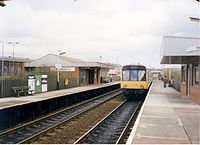
The coming of the railways led to further industrial development, a steady growth of population and the fusing of the separate settlements into the village of Bredbury. The first line was the Manchester, Sheffield and Lincolnshire Railway branch from Hyde Junction, which was opened to Hyde in 1858 and extended to Marple on 5 August 1862. The Stockport and Woodley Junction]] line, opened on 12 January 1863, was amalgamated into the Cheshire Lines Committee on 5 July 1865. The lines from Romiley Junction to Bredbury Junction and Ashburys were opened on 1 April 1875 and 2 August 1875, respectively, and on the latter date the branch from Brinnington to Reddish Junction was opened. On 1 February 1867, Midland Railway trains began to run through the village, as part of the Sheffield and Midland Railway Companies' Committee, to Manchester London Road, at first via Hyde and later via Reddish. The terminus was transferred to Manchester Central in 1880, trains running via Stockport Tiviot Dale.
There are now few traces of the coal mining that went back to the 17th century at least and in the 19th century was one of the bases of life in the village. The last colliery closed in 1926 and spoil heaps were levelled at Ashton Road and Stockport Road East in the 1960s to make way for new industrial development. Brick-making too was carried on in the village, with Jacksons Brickworks at Ashton Road surviving into the 1970s, and there were several large hat works, but the last of these closed in 1958.
Exors of James Mills were manufacturers of steel products for over 100 years, the company growing from a small building employing two men to the large Bredbury Steelworks on Lower Bents Lane, which at its height employed over 2,000 people. In the early part of the 20th century, the company began to roll steel and to produce bright steel, at one point becoming the largest producer of bright steel outside the United States. Other products were added from time to time, including cotters for locomotives and rolling stock, engineer's keys, taper pins, grooved fastenings for securing all kinds of assemblies, railway permanent way fastenings, rail lubricators and hot pressings of various types. In 1938 the company introduced lead-bearing steels to the United Kingdom, and in the 1960s developed free machining steels containing tellurium and an alloy replacement steel. The company was later acquired by GKN and closed down in 1985. The site has since been redeveloped for housing.
The firm of Lightbown Aspinall started making wallpaper in Pendleton in Lancashire, and in 1899, became part of the newly formed Wall Paper Manufacturers. In 1929, the plant was transferred to Brookfield Avenue, where the company produced Crown and Scene wallpapers and Crown Vinyl wall covering, employing 450 people. The site has since been redeveloped for housing.
Pear New Mill was owned by Combined English Mills and were spinners of superfine white hosiery yarn, employing over 400 people. The building has since been subdivided into industrial units.
William Crosland, an engineer and ironfounder, started business in 1855 in an upstairs room at Miller Street in Manchester. He was later joined by his four sons, and the company moved to Stockport Road West in 1894, manufacturing machines and cutting tools for the packaging industry and specialised machine tool|tooling for the sheet metal trade. The site has since been redeveloped as an industrial estate.[1]
20th century
In the 1930s, and after Second World War, the growth rate accelerated with the coming of new industries, including engineering, chemicals, clothing and textiles, whilst the village became an important residential area on the periphery of the expanding conurbation spreading out of Manchester. A large bakery was erected on Ashton Road in 1951.
Comprehensive sewerage and sewage disposal services were completed and put into operation in 1938.
In 1948, the tramway along the A560 from Stockport to Hyde and beyond was abandoned after less than 50 years use. The section through Bredbury had been opened in August 1901.
Landmarks
The village has extensive areas of attractive countryside, both in the river valleys and on the slopes of Werneth Low.
Arden Hall
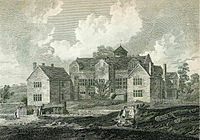
The most famous of the halls of Bredbury, Arden Hall, erected in 1597, is now a ruin standing in a commanding position above the valley of the River Tame. For over two centuries it was owned by the Ardernes, who had other possessions in Cheshire and were a junior branch of the Arden family of Warwickshire, of whom William Shakespeare's mother was a member.
In the particulars of sale of 1825, it states that "the ancient mansion house of Arden Hall has been in part converted into a commodious farm house, with every requisite convenience", and it had already been let as such.
There is a tradition that Oliver Cromwell stayed at the hall and that there was a skirmish nearby between Cavaliers and Roundheads, but there is no firm evidence, although the access to the hall is called Battle Lane. However, Ralph Arderne, like most other local gentry, espoused the Parliamentarian cause, and saw action in several engagements.
Bredbury Hall
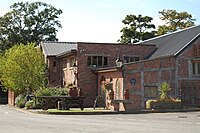
Bredbury Hall, approached from Dark Lane, has been so altered as to have lost every vestige of its former appearance. it was probably built upon the site of a former homestead, as some branch of the Bredburys is supposed to have settled here in early times.
In 1638, the hall was occupied by a branch of the Davenports, a connection of the Bredburys. In later times, the venerable building degenerated into an ordinary farmstead. In the 19th century, it was rebuilt, and converted into a fine family residence in the Georgian style.
The great barn, 42 yards long of cruck framed construction, is mediæval in origin although the original framing timbers have been overlaid by brick.
Now owned by the Flood family, Bredbury Hall is now a recognised Hotel and Country Club with an array of famous faces entering the doors every week from Worldwide darts personalities to the elite from the snooker world. The great barn is now renovated into a large nightclub which has 6 bars, 2 floors, pool, darts and a large dance floor.
Goyt Hall
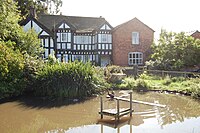
Goyt Hall, which stands in the valley of the River Goyt, midway between Otterspool Bridge and New Bridge, is a half-timbered building erected by Randal Davenport about the year 1570.
The marriage of the last of the Davenports in 1664 brought the hall into the possession of Sir Fulke Lucy, a kinsman of Sir Thomas Lucy who features in the story of William Shakespeare's youth. This rather tenuous association was marked by the naming of the streets on the nearby Shakespeare Estate, an overspill development built by Manchester City Council.
Harrytown Hall
Formerly occupied by the Convent of the Nativity of the Sisters of Charity of Notre Dame d'Évron, who maintained Harrytown High School, Harrytown Hall dates from 1671, and is well preserved in spite of being Gothicised during the Romantic Revival. The building was converted into apartments in the early 1980s.
Churches
- Church of England:
- St Mark
- St Barnabas
- United Reformed Church: Hatherlow United Reformed Church
- Roman Catholic: Our Lady and St Christopher
Bredbury was without a church until the middle of the 19th century, the site for which was donated by John Sidebotham of Kingston in Hyde. The new church, St Mark's, was consecrated on 17 January 1849, and the church school was opened in 1850.
Built of freestone in the Early English style, the church consists of a square tower having four pinnacles, a nave and aisles, and a chancel with a vestry on the north side. The tower is 70 feet tall, occupying a commanding position. It contains a clock and a peal of bells.
The Church School (now rebuilt), is on the opposite side of Redhouse Lane.
St Barnabus was built in the twentuieth century, and consecrated on 27 March 1954.
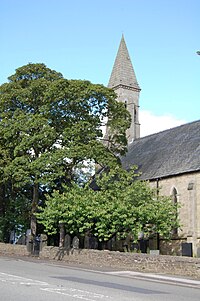
Hatherlow Church traces its history back to 1645, services then being held in Chadkirk Chapel, and it was the oldest Congregational body in Cheshire. The first independent minister at Chadkirk was Gamallel Jones, who settled there in 1688 or 1689. In the latter year the "Meeting Place" at Chadkirk was certified as a licensed place for religious worship shortly after the passing of the Act of Toleration 1689. When they were finally ejected in the reign of Queen Anne, a new building was erected in 1706 on the site now occupied by Hatherlow Sunday School.
The present church was opened as Hatherlow Congregational Church in 1845, although the burial ground surrounding it goes back to 1793. A day school was established in 1780 at Bredbury Old School on School Brow, and the building known as Top School on Gorsey Brow, now partially demolished, was built in 1830 as an overflow. The day school continued until it was succeeded by the Council school at Barrack Hill in 1909.
Outside links
References
- ↑ "William Crosland". British Industrial History. Grace's Guide. http://www.gracesguide.co.uk/William_Crosland. Retrieved 27 January 2013.
Books
- Aiken, John (1795). A Description of the County from 30 – 40 Miles Round Manchester
- Cocks, James (1895). Memorials of Hatherlow
- Cocks, James (1924). Annals of Bredbury Part 1
- Earwaker, J P (1880). East Cheshire
- Bredbury and Romiley Urban District : The Official Guide (1970)
- Biographical Notes on Sir Ernest Barker and Thomas Greenwood (1950)
- St Mark's Centenary Booklet (1949)